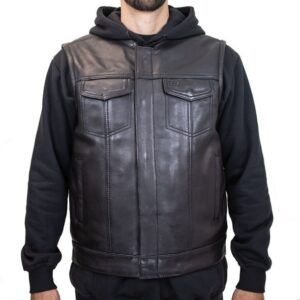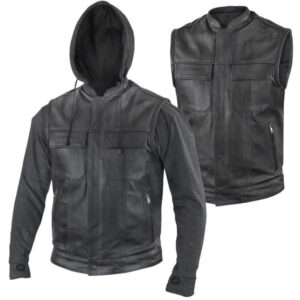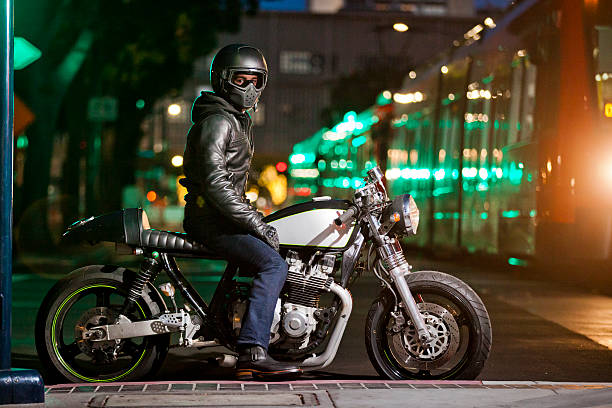The Unique Appeal of Biker Leather Vests over Jackets
The bikers gear leather vest represents style and usefulness in motorcycle equipment. Leather jackets are associated with motorcyclists, but many now choose leather vests for more practical reasons. Leather vests are preferred by many riders for practical, cultural, and comfort reasons.

First off, a leather vest is more mobile than a jacket. Riders have more arm and shoulder motion without sleeves, which is essential in traffic and curving roads. Safety and comfort are both at stake with this mobility. Rapid reflexes and maneuverability on a motorcycle are crucial, especially in unexpected situations. With the vest, riders can move freely and adapt quickly to any riding difficulty.
Another advantage of vests is temperature regulation. A leather vest balances warmth and ventilation for motorcycle riding. A jacket can overheat in sunny weather, but a vest keeps the core insulated and lets air circulate through the arms. Many riders find this more comfortable and pleasurable, especially on longer trips or in warmer areas.
The vest is a canvas for personal expression, a strong biker tradition. Bikers often put patches, club logos, and other personal symbols on their vests rather than jackets. Biker culture relies on customizing and displaying one’s individuality and associations, making the vest more than just apparel.
Vests also make it easier to carry essentials. Leather vests include interior and exterior wallets, phones, and essential pockets. Bikers who prefer to keep their goods protected and accessible without bags or luggage would find this beneficial.
Leather vests are as durable as jackets. High-quality leather is known for its durability. A sturdy leather vest can withstand wind, minor abrasions, and the elements on the road. A leather vest is a long-term travel companion due to its durability.
Vests are also preferred for their stylish adaptability and timelessness. Leather vests are suitable for riders who wish to look a certain way off the bike because they may be worn with several outfits. This versatility applies to urban and long-distance riding.
Finally, motorbike type and riding style can affect the leather vest over the jacket choice: vests compliment cruiser and touring bikes with a vintage design. However, sportbike riders may appreciate the vest’s lightweight, less restrictive design for their high-speed, nimble rides.
For functionality, comfort, personal expression, and design, leather vests have become a popular alternative to leather jackets in biker gear. Many bikers prefer its versatility, ease of movement, and adaptability to different riding circumstances. For the modern biker, a leather vest offers a unique blend of utility and uniqueness that is hard to equal, whether on the road or in the city.

Finding the Right Way: Biker Vest Ethics
The biker gear leather vest symbolizes individuality and belonging in motorcycle culture. Beyond usefulness and fashion, it explores biking’s ethos: is wearing a biker’s vest ‘right’? This study explores motorcycle vests’ ethical, cultural, and societal aspects, pushing us to go past the leather and thread into their more profound story.
This topic centers on respect and unwritten road norms. Biker vests typically represent motorcycle clubs. These symbols represent principles and community, not just decoration. Biker respect is violated by wearing a vest without earning it or misrepresenting connection. Like wearing a military uniform without serving, it appropriates a culture without comprehending or contributing to its principles.
The ethical implications of wearing a biker vest include representation. A vest, especially one with club colors or logos, makes the wearer an advocate for the club and the motorcycle community. Visibility comes with a responsibility to behave. Individuals’ actions affect the group’s public image and internal dynamics. Thus, wearing a vest is more than a fashion statement; it’s a social role.
The environmental and ethical impacts of leather production are also discussed. The leather biker vest is under review amid growing concerns about sustainability and animal cruelty. Popular synthetic leather substitutes approximate the look of leather without ethical issues. Social trends toward ethically sourced and environmentally friendly products are reflected in this transition. For many purists, genuine leather’s durability and vintage appeal are unrivaled.
Biker vests pose a safety problem. Despite its rugged, fearless appearance, it provides little physical protection compared to coats or armored clothes. This raises questions regarding self-responsibility and riding culture’s safety message. Bike safety is as crucial as choice. Community debates over the vest’s defensive abilities get complicated.
Vests have become widespread after motorcycle fashion was democratized. This popularization raises questions regarding cultural appropriation and vest symbolism. A culturally significant emblem becoming a fashion item can cause miscommunication. The question then turns to whether the vest’s symbolism should be protected or whether its incorporation into culture is natural.
Consider how biker vests promote diversity and inclusivity in the motorcycling community. Once considered monolithic, bicycle culture is evolving dramatically. Vests symbolize unity among bikers of all backgrounds. However, they can divide groups. The ethical dilemma is reconciling the vest’s position as a symbol of identification and belonging without using it to exclude.
Wearing biker vests, especially those connected with specific organizations, has legal and societal consequences. Wearing a vest with specific insignia may be illegal or lead to police profiling. Biker vest ethics are complicated by legality, personal expression, and social perception.
Respect, representation, sustainability, safety, cultural appropriation, inclusivity, and legality all factor into whether bikers should wear vests. Instead of providing a simple answer, it encourages ongoing discussion in the bike community and beyond. The motorcycle vest is a junction of cultural, ethical, and societal factors that make us question our fashion choices.
Its elegance, functionality, and cultural relevance in motorcycling make the leather biker vest more than just clothes. As we examine the ethical and practical issues surrounding leather motorcycle vests, we encounter a complex environment of respect, representation, sustainability, safety, and social attitudes.

Wearing a biker vest shows respect for the motorcycle club and its beliefs. It represents community; thus, wearing one without earning it or misrepresenting relationships violates this unwritten road etiquette. Like wearing a military uniform without serving, it appropriates a culture without understanding or contributing to its values.
Biker vests have ethical issues beyond representation. When someone wears a vest, especially one with club colors or logos, they promote the club and motorcycle community. This visibility requires club members to uphold their beliefs and behavior, as their actions might affect the group’s public image and internal dynamics.
Leather manufacture raises ethical and environmental issues. Genuine leather is questioned in an age of sustainability and animal welfare. Following social trends toward ethically sourced and environmentally sustainable items, synthetic leather alternatives offer similar looks without ethical issues. For many, authentic leather’s durability and old beauty are unsurpassed.





Leave a Reply